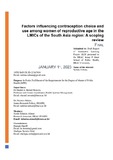Factors influencing contraception choice and use among women of reproductive age in the LMICs of the South Asia region : a scoping review
Abstract
Contraception is an important factor in determining the reproductive health and well-being of
women in low- and middle-income countries (LMICs). Women in these countries often face
barriers to accessing contraception, including cultural and societal barriers, lack of awareness
about available options, and lack of access to health facilities. As a result, many women in
LMICs are unable to make informed decisions about the type of contraceptive method that is
best suited to their needs and circumstances. In this study, our aim is to provide an overview
of the available evidences of the factors influencing contraception choice and use among
women of reproductive age (15-49 years) in LMICs of the South Asia region.
Methods:
We conducted a scoping review. We searched for articles from the following databases:
PubMed, Springer, and Google Scholar. The studies that were considered for the review were
published between the years 2012 and 2022. To report our screening results, we followed the
guidelines of the PCC framework and the PRISMA chart. The results of the searched
databases were transferred to a standard systematic review software (Rayyan) for further
management to determine the quality of the included studies and screening was done
following pre-determined criteria and two independent reviewers participated in the process.
Results:
Our title screening search criteria identified a total of 275 articles. Only 14 studies matched
our inclusion criteria and were included in the quality assessment stage. We found how the
knowledge, sociocultural factors, partner involvement, and health facilities related to access
to contraceptive methods are whether or not associated with the use and choice of
contraceptive methods and their common reason for discontinuation of contraceptive
methods.
Conclusion:
There is still a need to enhance educational programs, enhance access to a range of
contraceptive options and address the barriers that prevent women from making informed
decisions to enhanc

